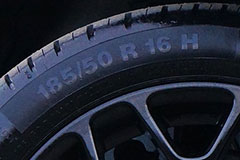How to Read Your Tire Markings - Vol.368
You're probably aware that there are many types of tires and that you just can't put any tire on your vehicle. Each car manufacturer recommends a very specific type of tires for each model, which best fits the car and ensures optimal performance. If you've ever gone tire shopping, you know that, when buying a new set of tires for your car, you need to specify certain number and letter combination that indicates a particular type of tire. For example, your car might use tires that are marked with "P215/65 R15 95H". This information can be found on the sidewall of your tire, but what exactly do those numbers and letters mean? Here's a neat little guide that will tell you exactly that.

The first letter in the sequence stands for P-Metric tire, which means that the tire is intended for passenger vehicles. This information is only present in the tires manufactured to certain standards in the United States. If a tire doesn't have a letter at the beginning of the information on sidewall marking, that means that it's Euro-metric tire. Here, we can also find letters "LT", which stand for Light Truck. The tires for this type of vehicle require higher inflation pressures compared to passenger vehicles.
The first number in the sequence refers to the width of the tire. The number, which represents millimeters, is the width of the tire measured from sidewall to sidewall. After that, we have the aspect ratio or, more specifically, the ratio of the height of the cross-section of the tire to its width. For example, an aspect ratio of 65 means that the height of the tire is equal to 65% of its width. The bigger this number is, the bigger the sidewall of the tire is going to be.
Next, we have the indicator for the construction. The letter "R" simply means that it's a radial tire. After that, we have the information concerning the Load Index. For example, if a tire has a Load Index of 91 that means that it can carry 615 kilograms of weight. Last, but not least, we have the Speed Rating. That's the last letter in the sequence on the tire markings. For example, if the sequence ends with an H that means that the tire is capable of maximum speeds of 210 km/h, or 130 mph.
But believe it or not, that's not all. If you take a careful look at your tires, you'll notice some additional information that might be of great importance. And no, we're not talking about the "Made in USA", but some other information, such as the DOT symbol. These three letters signify that the tire complies with applicable American Federal Motor Vehicle Safety Standards. After the DOT, there's the Tire Identification Number, which can consists of up to 12 numbers and letters. These indicate the location of the factory where the tire was manufactured, as well as the week and year it was produced. This can help you with the purchase, as you can avoid tires that were manufactured long time ago and that possibly were stored improperly.
Finally, there the Uniform Tire Quality Grading, or UTQG for short. This is a rating system that was developed by the U.S. Department of Transportation, and it contains information concerning traction and temperature. Namely, there's the Traction grade information, ranging from AA to C, the former indicating outstanding traction in wet conditions. And also, we have the Temperature grades, which is the information that tells you whether a tire is able to operate at higher speeds, withstanding higher temperatures generated by the friction.